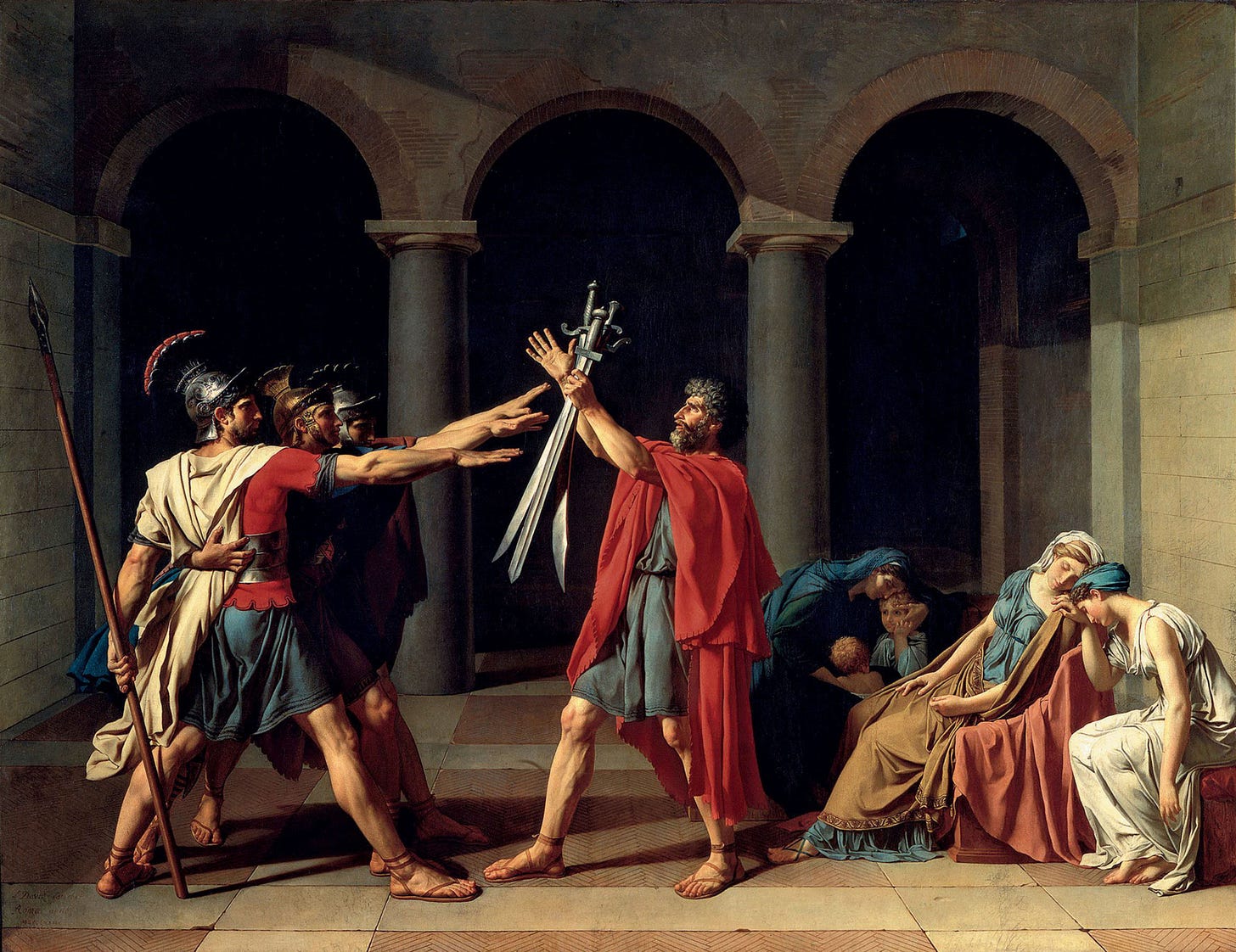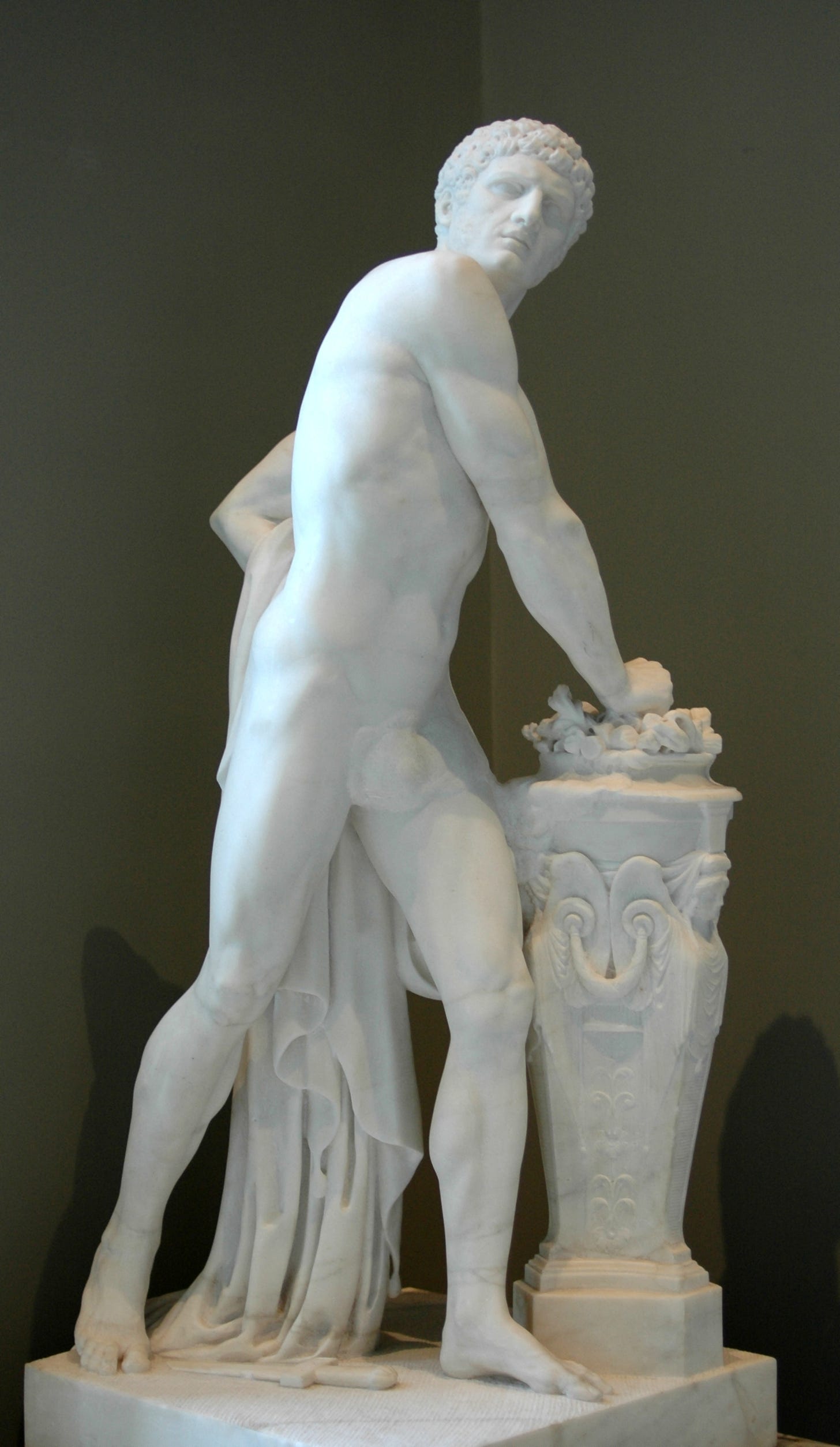Five Roman myths—part I
I was taught about these five stories when I was a kid. I’m revisiting them over half a century later to see what I can still learn from them.

When I was in elementary school, between the ages of six and ten (I skipped first grade, so I was there only four years), I had an absolutely wonderful teacher, Mrs. Darmond (of French origins). She was initially skeptical about my joining her classroom in second grade, worried about taking a chance on an unknown quantity and how I would fit with the rest of my classmates. But in fact things went very smoothly, and Mrs. Darmond eventually told my grandfather (with whom I grew up) that she had made a splendid decision in accepting me.
One of the subjects Mrs. Darmond was teaching us was history, which of course included the ancient Roman period. It was taught at a level appropriate to our age, characterized by a main body of facts sprinkled all over with a bit of mythology, aimed at instilling in us not just historical truths but also moral lessons. Teaching, as they say, consists in lying by different degrees, and at any rate the notion that moral lessons are more important than naked facts has a long tradition in Greco-Roman culture (think of Plutarch’s Parallel Lives, for instance). I’ll get back to this way of framing things, as well as to its darker side—propaganda for an imperialist nation—in the second part of this essay.
For some reason, five specific episodes from the early history of Rome still surface to my mind, from time to time, so I want to tell you about them. They all refer to semi-legendary events (meaning, events rooted in historical facts, but embellished or distorted through retelling and the passage of time) that “occurred” in either Pre-Republican or Republican Rome.
Ancient Rome went through three major periods, in terms of its form of government: the city was founded by the (again, semi-legendary) Romulus on April 21, 753 BCE, a suspiciously precise date, though the approximate period is backed up by archeological evidence. Early Rome had seven kings: Romulus himself, Numa Pompilius, Tullus Hostilius, Ancus Marcius, Lucius Tarquinius Priscus, Servius Tullius, and Lucius Tarquinius Superbus. They ruled The city on the seven hills until 509 BCE, when Superbus—who by all accounts was a tyrant—was kicked out after a revolt triggered when his son raped a noblewoman, Lucretia. Incidentally, the revolt was headed by Lucius Junius Brutus, a direct ancestor of the Marcus Junius Brutus who dispatched of another tyrant, Julius Caesar, on the Ides of March 44 BCE, more than 450 years later.
Anyway, after the monarchical period, Rome became a Republic—the other major democracy of the ancient world other than Athens—until the just mentioned Caesar managed to set in motion the events that will result in the ascent of Octavian, later know as Augustus, the first Roman Emperor, who began reigning on 16 January 27 BCE. That was the third and last phase of the evolution of Ancient Rome, which ended in 476 CE with the deposition of the last Western Emperor, Romulus Augustulus, by Odoacer (of uncertain ethnic origin, though often referred to as a Goth). The Eastern, or Byzantine, empire, went on for much longer, finally yielding to the expansion of the Ottoman Empire in 1453, in the middle of the Renaissance.
Okay, enough with the historical background. Let’s get to the stories, beginning with the curious episode of the Orazi and Curiazi.
(I) How to put end to a war
Titus Livius, known as Livy, is the main source for this one (Historiae, I.24-25). During the period of Tullius Hostilius, the third King of Rome (reigned 672-640 BCE), the city was at war with one of its neighbors, Alba Longa (modern Castel Gandolfo, in the Alban Hills). This was kind of embarrassing, because legend said that Rome and Alba Longa were fraternal cities, since the latter was founded by Ascanius, the son of Aeneas, the Trojan hero who (allegedly) founded the royal dynasty to which Romulus (and his unfortunate twin Remus) belonged.
How to resolve the dilemma and decide which city should bow to the other while minimizing the bloodshed? By picking three champions for each side and having them fight against each other. The winning side will then obtain the willing submission of the other city. Alba Longa chose the three Curiatii brothers (legend says they were a triplet) while Rome chose the three Horatii brothers.
The confrontation did not begin well for Rome, as two of the Horatii were quickly dispatched by their Curiatii counterparts who, however, were wounded in different ways during the fight. The remaining Horatius brother, Publius, could not possibly have faced them all at once, so he started running toward Rome. Thinking him a coward, the Curiatii went after him, but because they were differently wounded, they ran at different paces, thus distancing themselves from each other.
This allowed Publius at some point to suddenly stop, turn, and face the first Curiatius, killing him. Publius then resume running, stopped again to face the second Curiatius, and so on, until he had killed all three of them. Rome won the day, and Alba Longa became one of the first Roman subjects.
So far the story I was told by Mrs. Darmond. She neglected to tell us something about the aftermath: it turns out that Publius Horatius’s sister, Camilla, was engaged with one of the now deceased Curiatii. When she saw her brother coming back carrying with the cloak she had given to her betrothed, she understandably began to wail in despair. Publius proclaimed that it was unbecoming of a Roman woman to mourn an enemy of Rome and killed his sister.
This, even at the time, was not kosher, so Publius was condemned to death for having slain a Roman citizen. However, Publius’s father appealed to the citizens, reminding them that it was because of the bravery and cunning of his son that Rome was not now a subject of Alba Longa. In consideration of this, the popular assembly commuted the sentence and Publius had to purify himself by walking under the Tigillum Sororium, initially a wooden structure that eventually became the first arch in Rome. From then on, Roman soldiers returning from war would follow the tradition inaugurated by Publius, purifying themselves from the horrors of battle.
We kids were also not told the real story: the war between Rome and Alba Longa was actually long and violent, ending in the quartering of the losing king, Mettius Fufetius.

(II) Trusting your hand into the fire
In Italian when someone is particularly confident about something they say “Ci metto la mano sul fuoco,” which translates to “I will put my had into the fire,” meaning that one is certain of saying or doing the right thing. The phrase comes from the second semi-legendary tale I’m going to regale you with, that of Gaius Mucius, nicknamed (by the end of the story) “Scaevola,” meaning left-handed.
This story is told by Livy (Historiae, II.12-13) as well as by Dionysius of Halicarnassus and Plutarch. It was the year 508 BCE, which means that the Roman Republic had just been established, the year before. Rome was at war with the Etruscan city of Clusium (modern Chiusi), were the king was Lars Porsena. Things were not going well for the Roman side, and Porsena actually got to lay siege to Rome. In a desperate attempt to avert final catastrophe, the young Gaius Mucius volunteered a likely suicidal mission: sneak into the Etruscan camp and kill Porsena.
The attempt failed and Gaius was captured and brought in front of the king. While being questioned, Gaius declared: “I am a Roman citizen, men call me Gaius Mucius. I came here as an enemy to kill my enemy, and I am as ready to die as I am to kill. We Romans act bravely and, when adversity strikes, we suffer bravely.” That said, he trusted his right hand, the one that had failed the mission, into the sacred fire burning in front of him, holding it there despite the excruciating pain. This is why, afterwards, he was given the nickname “Scaevola.”
Moreover, he told Porsena that there were three hundred more Roman youths ready to follow in his footsteps, until one of them would eventually succeed. This, apparently, was not true, but the gamble—together with his display of courage—paid off. Porsena let Gaius go and withdrew his army to go take care of other troubling spots at the boundaries of his kingdom.
The war between Rome and Clusium did historically happen, and it ended with a peace treaty, though modern historians don’t think the siege by Porsena took place. A year later Porsena returned to Roman territory, demanding that the Romans allowed back their last king, Tarquinius Superbus, who had taken refuge at Porsena’s court. The Romans adamantly refused, and Porsena left, advising Tarquinius to seek political asylum elsewhere.

(III) Gold vs iron
On 18 July 390 BCE Rome was sacked by a tribe of Senones Gauls under the command of Brennus, such a low point during the history of the Republic that the date, known as dies Alliensis (day of the Allia, the river near which the Roman army had been defeated) became synonymous with misfortune.
The Gauls burned the city, got into the Senate and slaughtered the Senators who were there in session. Only a small number of troops resisted by barricading themselves on the Capitoline Hill, the highest of the seven hills.
According to Livy (Historiae, V.41, though the story is also told by Polybius, Diodorus Siculus, Plutarch, and Strabo) the attackers split their forces into two, leaving a contingent to continue the siege and sending the other to raid the nearby countryside. By this time, news of the sack had reached the Roman general Marcus Furius Camillus, who had urgently made “dictator”—that is, emergency commander in chief—to deal with the crisis. Marcus managed to ambush the Gallic contingent that had left the city, inflicting a serious defeat to the invader.
Meanwhile, a rather still self-confident Brennus was negotiating the withdrawal from Rome, because the situation was changing there as well, as the Gauls had been stricken by a sudden epidemic. As a condition for leaving, Brennus imposed the payment of one thousand pounds of gold and set up a scale in the Forum to weigh the ransom. Not only the scale was weighted unfairly, at the last moment he added his own sword in order to further increase the amount of gold to be paid out.
It is at this moment, according to legend, that Furius Camillus irrupted on the scene, put his own sword on the other side of the scale, and said “Non auro, sed ferro, recuperanda est patria!” — It is not with gold, but with iron, that the motherland will be rescued!
Immediately after, the Gauls suffered two more crucial defeats and had to abandon any further plans they had concerning Rome. Some modern historians suggest that an additional incentive to leave was given to the Gauls by the fact that the Veneti (inhabitants of the modern region around Venice) were threatening Gallic territory. The point here clearly is to highlight patriotism, courage, and justice (at least, as seen from the Roman perspective).

[Next time: The Punic Wars!]



